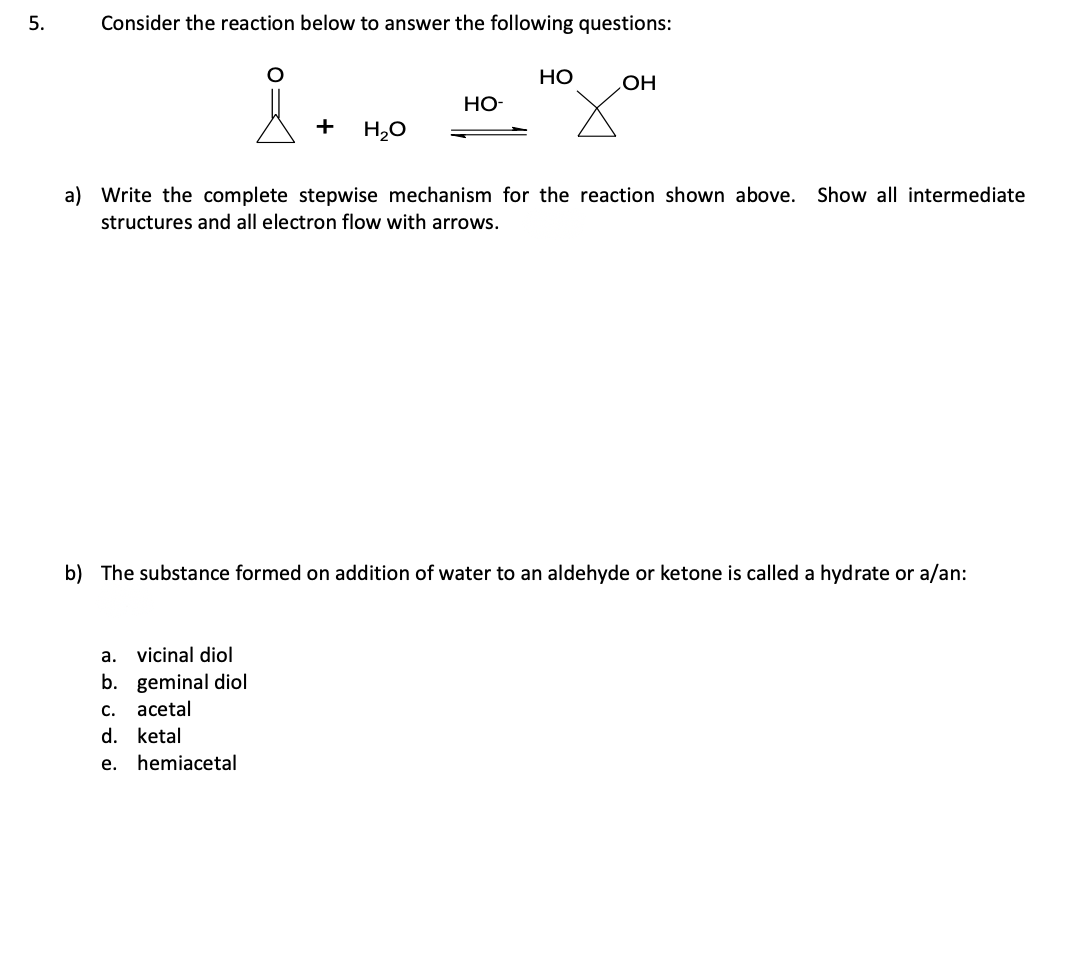5. Consider the reaction below to answer the following questions: + H₂O HO- a. vicinal diol b. geminal diol C. acetal d. ketal e. hemiacetal HO OH X a) Write the complete stepwise mechanism for the reaction shown above. Show all intermediate structures and all electron flow with arrows. b) The substance formed on addition of water to an aldehyde or ketone is called a hydrate or a/an:
5. Consider the reaction below to answer the following questions: + H₂O HO- a. vicinal diol b. geminal diol C. acetal d. ketal e. hemiacetal HO OH X a) Write the complete stepwise mechanism for the reaction shown above. Show all intermediate structures and all electron flow with arrows. b) The substance formed on addition of water to an aldehyde or ketone is called a hydrate or a/an:
Chemistry
10th Edition
ISBN:9781305957404
Author:Steven S. Zumdahl, Susan A. Zumdahl, Donald J. DeCoste
Publisher:Steven S. Zumdahl, Susan A. Zumdahl, Donald J. DeCoste
Chapter1: Chemical Foundations
Section: Chapter Questions
Problem 1RQ: Define and explain the differences between the following terms. a. law and theory b. theory and...
Related questions
Question

Transcribed Image Text:5.
Consider the reaction below to answer the following questions:
+ H₂O
a. vicinal diol
b. geminal diol
c. acetal
d. ketal
e.
HO-
hemiacetal
HO
a) Write the complete stepwise mechanism for the reaction shown above. Show all intermediate
structures and all electron flow with arrows.
OH
b) The substance formed on addition of water to an aldehyde or ketone is called a hydrate or a/an:

Transcribed Image Text:c) Many nucleophilic addition reactions of aldehydes and ketones are catalyzed by acid or base. Bases
catalyze hydration is useful by:
a. making the carbonyl group more electrophilic
b. shifting the equilibrium of the reaction
c. making the carbonyl group less electrophilic
d. converting the water into hydroxide ion, a much better nucleophile
e. converting the water into hydroxide ion, a much better electrophile
Expert Solution
This question has been solved!
Explore an expertly crafted, step-by-step solution for a thorough understanding of key concepts.
Step by step
Solved in 2 steps with 1 images

Knowledge Booster
Learn more about
Need a deep-dive on the concept behind this application? Look no further. Learn more about this topic, chemistry and related others by exploring similar questions and additional content below.Recommended textbooks for you

Chemistry
Chemistry
ISBN:
9781305957404
Author:
Steven S. Zumdahl, Susan A. Zumdahl, Donald J. DeCoste
Publisher:
Cengage Learning

Chemistry
Chemistry
ISBN:
9781259911156
Author:
Raymond Chang Dr., Jason Overby Professor
Publisher:
McGraw-Hill Education

Principles of Instrumental Analysis
Chemistry
ISBN:
9781305577213
Author:
Douglas A. Skoog, F. James Holler, Stanley R. Crouch
Publisher:
Cengage Learning

Chemistry
Chemistry
ISBN:
9781305957404
Author:
Steven S. Zumdahl, Susan A. Zumdahl, Donald J. DeCoste
Publisher:
Cengage Learning

Chemistry
Chemistry
ISBN:
9781259911156
Author:
Raymond Chang Dr., Jason Overby Professor
Publisher:
McGraw-Hill Education

Principles of Instrumental Analysis
Chemistry
ISBN:
9781305577213
Author:
Douglas A. Skoog, F. James Holler, Stanley R. Crouch
Publisher:
Cengage Learning

Organic Chemistry
Chemistry
ISBN:
9780078021558
Author:
Janice Gorzynski Smith Dr.
Publisher:
McGraw-Hill Education

Chemistry: Principles and Reactions
Chemistry
ISBN:
9781305079373
Author:
William L. Masterton, Cecile N. Hurley
Publisher:
Cengage Learning

Elementary Principles of Chemical Processes, Bind…
Chemistry
ISBN:
9781118431221
Author:
Richard M. Felder, Ronald W. Rousseau, Lisa G. Bullard
Publisher:
WILEY